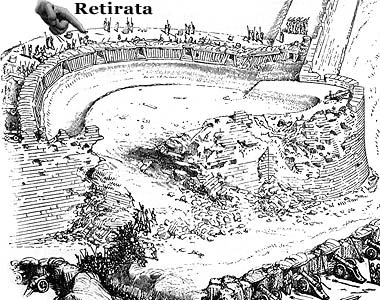 |
Success Against Artillery: Pisa, 1500 |
As the new offensive force of artillery displayed its power in Italy in 1494, the first effective defense against that artillery was demonstrated also in Italy a mere six years later. This was the wall as a low-profile rampart with a ditch in front.
 In
1500, Pisa broke with Florence, which then asked for and received
aid from the French to bring the upstart city of Pisa back under
Florentine control. A combined force of French and Florentines
laid siege to Pisa. In short order the French artillery began
hammering the Pisan wall. But! The Pisans, by then wise to the
power of cannon against the fragility of their vertical stoneware,
fashioned an earthen rampart, with ditch before it, behind (but not
part of) the particular wall being battered by French cannon - think
of a defense within a defense. After the wall was soon breached,
French foot surged through the opening. They were met with:::
Another barrier! With feisty Pisans atop and behind it. The
enthusiasm the French had for the assault dropped lower than the
ditch in front of them, and soon they and their Florentine clients
abandoned the siege. (Only a blockade in 1509 compelled Pisa to bow
again before the feet of Florence.)
In
1500, Pisa broke with Florence, which then asked for and received
aid from the French to bring the upstart city of Pisa back under
Florentine control. A combined force of French and Florentines
laid siege to Pisa. In short order the French artillery began
hammering the Pisan wall. But! The Pisans, by then wise to the
power of cannon against the fragility of their vertical stoneware,
fashioned an earthen rampart, with ditch before it, behind (but not
part of) the particular wall being battered by French cannon - think
of a defense within a defense. After the wall was soon breached,
French foot surged through the opening. They were met with:::
Another barrier! With feisty Pisans atop and behind it. The
enthusiasm the French had for the assault dropped lower than the
ditch in front of them, and soon they and their Florentine clients
abandoned the siege. (Only a blockade in 1509 compelled Pisa to bow
again before the feet of Florence.)
What the Pisans made was referred to as a "retirata." The Venetians expanded on the retirata for their defenses at Padua in 1509.
A retirata was a 'make-do' retrofit. After Pisa and Padua, the basic concept of its rampart and ditch was put to use in the development of new defenses to replace the old.
Low, thick walls, with a base considerably wider than the wall's height, could not topple over. With an interior of fill, usually earth and/or rock, such a wall could absorb one cannonball after another (in the days before exploding shot was fired from cannons). Low, thick walls became the fundamental strength of a new type of defensive design.
| Back |
Rampart & Ditch |
|
|
|